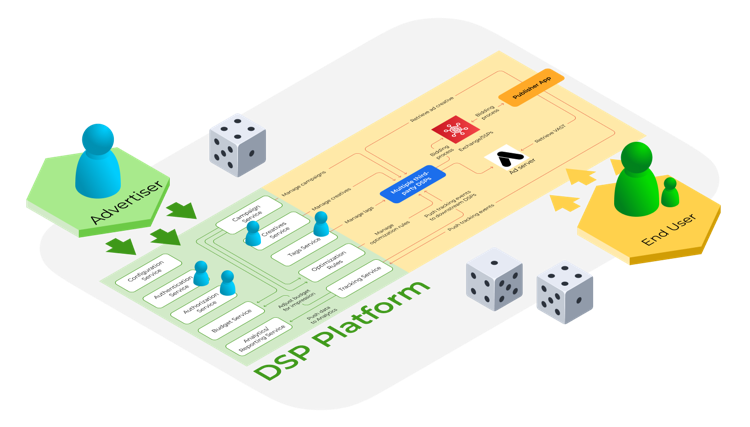
Imagine the deck of cards on the table where each is a challenge, and you’re looking to kick back and laugh. When the tensions run high, the game ceases to be fun, turning into a relentless passion for victory.
The daily routine of an ad ops manager, whether they work for a marketing agency or represent a web content publisher, is pretty much like a board game. Stumbling blocks are all around, even when they do not expect them. Not that ad ops managers should “beat the card” in the blink of an eye. Otherwise, the challenge isn’t considered accepted, and the cost of failure is too high, like lost revenue, customer churn, or rising TCO.
Are there lifehacks for ad ops managers to come out on top even when the cards and fortune seem to be against them? We’ve gathered grandmasters around the table for the Ad Ops Challenge board game.
Meet Vladimir Lyubarskiy, Oxagile’s Chief Solution Architect, who’s an old hand at this game, continually interacting with ad tech clients, knowing their reasons for frustration inside out, and helping them deal with it.
We also have a guest, Oxagile’s ad tech expert partner and advisor, to absorb his business advice on how to counteract ad ops issues — whether a supply or demand-side pain — on the go.
Are you up for the Ad Ops Challenge board game?
Showing the First Card “DSP Diversity”
What challenges does it hide?
Disparate statistics
Scenario Behind
An advertising operations manager at a marketing agency is sick and tired of accumulating ad statistics from miscellaneous demand-side platforms. Aiming to address all client wishes, the agency picked five DSPs for daily use, including DV360, The Trade Desk, and Samsung DSP, which added to the headache caused by exhausting reporting activities.
Days are stolen from extracting data from several isolated systems and then aggregating uncoordinated reports into one clear picture to demonstrate ad efficacy. Good old methods like Google Docs do not work, as they’re more about manual operations than process automation. The question is, how to redeem the ad ops manager from professional burnout?
What the Move Should Be
Vladimir Lyubarskiy: “That’s exactly the story we banged against while liaising with a digital advertising agency operating across the Latin American market. A couple of DSPs were actively utilized – and tons of side effects to overcome, among which was a daily reporting challenge.
Instead of persuading the client to make do with obsolete would-be reporting tools, our team designed the architecture of a DSP aggregator solution. Its primary benefit for reporting was the ability to gather the advertising statistics from all DSPs to introduce meaningful dashboards to all interested parties.”
AdTech advisor: “Occasionally, the DSP Diversity card represents a no less serious challenge for ad ops managers serving the supply side’s best interests. They’re permanently watching how their inventory spaces perform, aiming to generate win-win sales packages that are both highly demanded by their clients and profitable for their business.
An aggregation tool can go far beyond DSP functionality and speed up getting the insights for AdOps specialists responsible for managing multiple supply-side solutions.”
Image: DSP aggregator solution architecture
The Next Card Is “Campaign Setup”
Is any challenge concealed?
Wasting time and efforts
Scenario Behind
The more manual movements involved, the higher the risks of errors during the ad campaign setting processes. An AdOps manager, who works for a digital advertising company, relies on a handful of DSPs, which slows down the launch of any advertising activities.
Despite utmost concentration, he’s not immune to flaws, as each system incorporates a few specific nuances related to ad campaign tunes. Maneuvering between different DSPs commonly crystallizes in accidental processing lapses. What about fixing this human-centered, error-prone paradigm?
What the Move Should Be
AdTech advisor: “It’s not rocket science, but automation is key. The right strategy is to seize the opportunity given by ad campaign runner software solutions instead of going on with tiresome hand labor leading AdOps managers to nowhere or too ungrateful processing and poor ad campaign outcomes.
On top of multiple DSPs, such tools introduce a common UI for ad campaign setup. No need to follow a longer route by switching between DSPs and tracking custom settings for each. You want to make essential changes once, and they’ll be scaled across all DSPs.”
Vladimir Lyubarskiy: “That’s the scheme that works for our AdOps Challenge board game in case ad operations specialists suffer from the tedious ad campaign creation. From a technical perspective, it’s possible to integrate all DSPs taking part in the ad campaign management under one roof through an API – no cheating, process optimization only. A unified UI marvels when there’s a need to switch between ad campaigns and perform tiny fixes instantly.
It’s High Time for the “Performance Metrics” Card
Any hidden threats?
No unified measurement
Scenario Behind
The heterogeneity of ad campaign performance metrics, depending on distribution channels (linear, digital, or CTV) and geo, audience, and device type, hinders an AdOps manager from making up an all-embracing picture of an ad campaign’s success. When clients’ expectations are not satisfied due to the absence of measurability standards (they’re frustrated by disputable performance measurements), the AdOps specialist experiences the drawbacks of linear TV measurement and fights against CTV attribution issues.
Feeling the acute need for a functional measurement solution, he’s querying which would be the best bet here.
What the Move Should Be
Vladimir Lyubarskiy: “Some of the ad campaign requirements can be addressed by involving existing platforms and audience measurement products like Samba TV.
Pay heed to Nielsen, which laid a foundation for linear TV advertising measurement. Despite being considered a bit outdated, it’s moving forward and introducing a new Nielsen ONE Ads product for measuring media. Comscore, VideoAmp, and iSpot.tv also act as advanced solutions for ratings and audience measurement.”
Let’s Move on to the Card “Smart Targeting”
What does it keep from us?
Lack of data
Scenario Behind
A marketing agency’s bidding around all media channels is still far from the ultimate bidding strategy. The absence of their data for a more thorough analysis prevents them from enriching DSPs’ significant data selection. Is a shift from an all-around ad presence to smart bidding possible? And if so, what are the ways to target more wisely and access lucrative audience categories?
What the Move Should Be
AdTech advisor: “While marketing agencies suffer from the lack of fully owned audience records, even companies with the ability to collect such data also experience targeting issues. Significant data losses are common after the data management platform (or DMP) processing steps in, so it becomes challenging to reap their fruits.
To recap, brands with data sets can’t avoid a partial leakage after sending data to DMPs when bringing them to a common standard. No in-house data available? This case jeopardizes the efficiency of ad targeting.”
Vladimir Lyubarskiy: “To be fair, publishers and content owners are not sitting on their hands, continually combating this data lack issue through metadata enhancements. Although metadata management allows for enriching audience data with contextual, some unsatisfied demands on the advertisers’ side remain. The latter needs a more thorough understanding of the environment where their ad assets occur. And there are grounds for hope.
Time to get out a Joker from the sleeve. Its name is Computer Vision, and this is one of the true ways to improve ad targeting tactics with AI technologies to gather contextual data for better comprehension of the audience’s needs. The prize will be optimized conversions.”
“Order Management” Card Enters the Game
What can go wrong here?
Reconciliation hurdles
Scenario Behind
An ad ops manager in charge of order management and tracking often finds himself at the crossroads, thinking about how not to get lost in numerous accounts and accurately process both incoming and outcoming payments.
In the meantime, multicurrency accounts and systems should be carefully managed, and this process is not necessarily automated, so the ad ops specialist should watch all transactions closely.
Profit margin calculations also request careful guidance to gauge the revenue degree. Is this process doomed to chronic manual operations?
What the Move Should Be
Vladimir Lyubarskiy: “Not necessarily, if we choose the automation path again. This will provide us with a tool for accumulating all systems and line items to answer the question “Who owes who?” and generate unified reports transparently depicting all payment transactions.”
“Client Collaboration” Card Comes Into Play
There’s the snag!
Processing lags
Scenario Behind
A huge TV production studio embracing many digital and linear channels is actively targeted at monetizing advertising across all these platforms. What’s going on now? The truth is that an ad ops manager feels ill at ease trying to wade through the info on the available ad inventory spaces scattered across a range of applications. Selling flow processing is full of pitfalls, which unsettles the advertising operations specialist and results in a few mistakes. Clients seem furious as their requests are kept on ice, and above all, it takes ages to generate competitive ad inventory offerings for advertisers the production studio collaborates with.
What the Move Should Be
Vladimir Lyubarskiy: “Here I see the demand for converged video ad workflows around a multi-platform content distribution model. So this time, our Joker is likely to be called automation – we’re coming closer to the goal of monetizing advertising on both linear TV and digital (OTT) channels in an efficient fashion, leveraging an established process from direct sales of primary inventory to programmatic to backfill remnant inventory.
A custom software solution will let the ad inventory seller switch between numerous apps, increasing the overall converged efficiency of an ad selling flow. Regarding the already existing options that help you manage linear and digital ads with relative ease, these are WideOrbit and Landmark. I’m not saying they are a plaster for all sores – they’re still offering different flows for linear and digital, which clamors for further adjustments.”
Last but Not Least: “Chasing Higher Sales Revenue” Card
What lies beneath?
Forecasting gaps
Scenario Behind
Being a part of the TV industry’s leading content provider and distributor, an ad ops manager is becoming increasingly puzzled when brands and marketing agencies request the approximate spend on ad inventory. Making a bad bargain is likely to happen if not to generate different inventory package prices. But how do you determine which inventories should be higher priced so as not to sell too cheap?
What the Move Should Be
Vladimir Lyubarskiy: “I’d create a solution powered up with prediction mechanisms, letting AdOps specialists forecast impressions as accurately as possible across linear and digital channels. Why is it advantageous for both parties? The content distributor generates converged ad sales packages and determines premium inventory spaces, thus maximizing revenue, while their clients get a transparent picture of upcoming expenses.”
Is there an AdOps Challenge card that’s still in the deck, unopened, that you want to beat? Oxagile has more Ad Tech tricks to help you achieve that. Just give them a sign, and you’ll triumph in this game.
